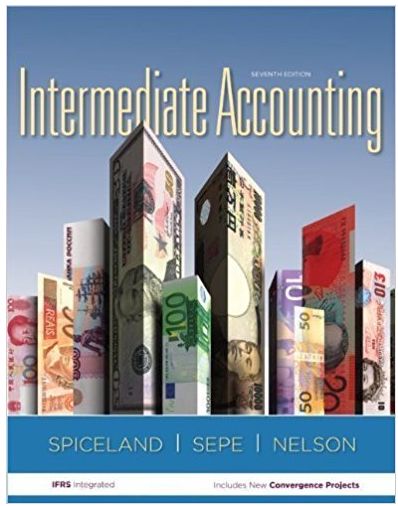The following questions are adapted from a variety of sources including questions developed by the AICPA Board
Question:
The following questions are adapted from a variety of sources including questions developed by the AICPA Board of Examiners and those used in the Kaplan CPA Review Course to study pensions and other postretirement benefits while preparing for the CPA examination. Determine the response that best completes the statements or questions.
1. Wolf Inc. began a defined benefit pension plan for its employees on January 1, 2013. The following data are provided for 2013 as of December 31, 2013:
Projected benefit obligation ............ $385,000
Accumulated benefit obligation ........... 340,000
Plan assets at fair value .............. 255,000
Pension expense .................. 95,000
Employer’s cash contribution (end of year) ....... 255,000
What amount should Wolf report as a net pension liability at December 31, 2013?
a. $ 0
b. $ 45,000
c. $ 85,000
d. $130,000
2. A statement of comprehensive income for a company with a defined benefit pension plan does not include
a. net income.
b. the return on plan assets.
c. gains from the return on assets exceeding expectations.
d. losses from changes in estimates regarding the pension obligation.
3. JWS Corporation has a defined benefit pension plan. JWS reported a net pension liability in last year’s balance sheet. This year, the company revised its estimate of future salary levels causing its projected benefit obligation estimate to decline by $8. Also, the $16 million actual return on plan assets was less than the $18 million expected return. As a result
a. the net pension liability will decrease by $8 million.
b. the statement of comprehensive income will report a $2 million gain and an $8 million loss.
c. the net pension liability will increase by $6 million.
d. accumulated other comprehensive income will increase by $6 million.
4. Amortizing a net gain for pensions and other postretirement benefit plans will
a. decrease retained earnings and decrease accumulated other comprehensive income.
b. increase retained earnings and increase accumulated other comprehensive income.
c. decrease retained earnings and increase accumulated other comprehensive income.
d. increase retained earnings and decrease accumulated other comprehensive income.
5. At December 31, 2012, Johnston and Johnston reported in its balance sheet as part of accumulated other comprehensive income a net loss of $37 million related to its postretirement benefit plan. The actuary for J&J increased her estimate of J&J’s future health care costs at the end of 2013. J&J’s entry to record the effect of this change will include
a. a debit to other comprehensive income and a credit to postretirement benefit liability.
b. a debit to postretirement benefit liability and a credit to other comprehensive income.
c. a debit to pension expense and a credit to postretirement benefit liability.
d. a debit to pension expense and a credit to other comprehensive income.
Beginning in 2011, International Financial Reporting Standards are tested on the CPA exam along with U.S. GAAP. The following questions deal with the application of IFRS to pensions.
6. Actuarial (Remeasurement) gains and losses are reported as OCI as they occur using
a. U.S. GAAP.
b. IFRS.
c. Both U.S. GAAP and IFRS.
d. Neither U.S. GAAP nor IFRS.
7. Prior (Past) service cost is included among OCI items in the statement of comprehensive income and thus subsequently becomes part of AOCI where it is amortized over the average remaining service period using
a. U.S. GAAP.
b. IFRS.
c. Both U.S. GAAP and IFRS.
d. Neither U.S. GAAP nor IFRS.
8. Prior (Past) service cost is expensed immediately using
a. U.S. GAAP.
b. IFRS.
c. Both U.S. GAAP and IFRS.
d. Neither U.S. GAAP nor IFRS.
Generally Accepted Accounting Principles (GAAP) is the accounting standard adopted by the U.S. Securities and Exchange Commission (SEC). While the SEC previously stated that it intends to move from U.S. GAAP to the International Financial Reporting Standards (IFRS), the... Balance Sheet
Balance sheet is a statement of the financial position of a business that list all the assets, liabilities, and owner’s equity and shareholder’s equity at a particular point of time. A balance sheet is also called as a “statement of financial... Corporation
A Corporation is a legal form of business that is separate from its owner. In other words, a corporation is a business or organization formed by a group of people, and its right and liabilities separate from those of the individuals involved. It may...
Step by Step Answer:

Intermediate accounting
ISBN: 978-0077647094
7th edition
Authors: J. David Spiceland, James Sepe, Mark Nelson





